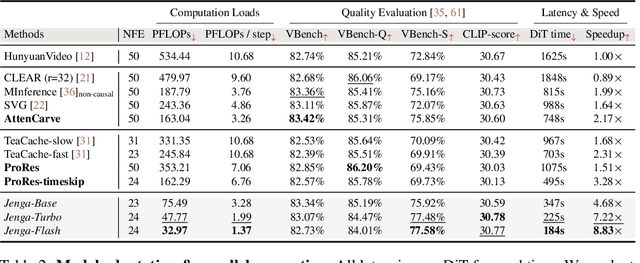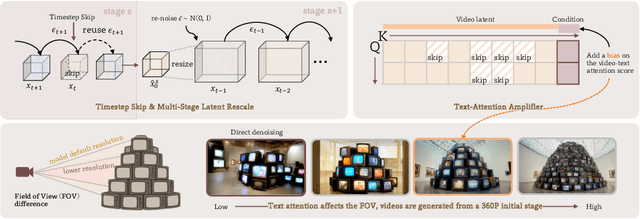Xin Tao
Terra: Explorable Native 3D World Model with Point Latents
Oct 16, 2025Abstract:World models have garnered increasing attention for comprehensive modeling of the real world. However, most existing methods still rely on pixel-aligned representations as the basis for world evolution, neglecting the inherent 3D nature of the physical world. This could undermine the 3D consistency and diminish the modeling efficiency of world models. In this paper, we present Terra, a native 3D world model that represents and generates explorable environments in an intrinsic 3D latent space. Specifically, we propose a novel point-to-Gaussian variational autoencoder (P2G-VAE) that encodes 3D inputs into a latent point representation, which is subsequently decoded as 3D Gaussian primitives to jointly model geometry and appearance. We then introduce a sparse point flow matching network (SPFlow) for generating the latent point representation, which simultaneously denoises the positions and features of the point latents. Our Terra enables exact multi-view consistency with native 3D representation and architecture, and supports flexible rendering from any viewpoint with only a single generation process. Furthermore, Terra achieves explorable world modeling through progressive generation in the point latent space. We conduct extensive experiments on the challenging indoor scenes from ScanNet v2. Terra achieves state-of-the-art performance in both reconstruction and generation with high 3D consistency.
Mitigating the Noise Shift for Denoising Generative Models via Noise Awareness Guidance
Oct 14, 2025Abstract:Existing denoising generative models rely on solving discretized reverse-time SDEs or ODEs. In this paper, we identify a long-overlooked yet pervasive issue in this family of models: a misalignment between the pre-defined noise level and the actual noise level encoded in intermediate states during sampling. We refer to this misalignment as noise shift. Through empirical analysis, we demonstrate that noise shift is widespread in modern diffusion models and exhibits a systematic bias, leading to sub-optimal generation due to both out-of-distribution generalization and inaccurate denoising updates. To address this problem, we propose Noise Awareness Guidance (NAG), a simple yet effective correction method that explicitly steers sampling trajectories to remain consistent with the pre-defined noise schedule. We further introduce a classifier-free variant of NAG, which jointly trains a noise-conditional and a noise-unconditional model via noise-condition dropout, thereby eliminating the need for external classifiers. Extensive experiments, including ImageNet generation and various supervised fine-tuning tasks, show that NAG consistently mitigates noise shift and substantially improves the generation quality of mainstream diffusion models.
Easier Painting Than Thinking: Can Text-to-Image Models Set the Stage, but Not Direct the Play?
Sep 03, 2025Abstract:Text-to-image (T2I) generation aims to synthesize images from textual prompts, which jointly specify what must be shown and imply what can be inferred, thereby corresponding to two core capabilities: composition and reasoning. However, with the emerging advances of T2I models in reasoning beyond composition, existing benchmarks reveal clear limitations in providing comprehensive evaluations across and within these capabilities. Meanwhile, these advances also enable models to handle more complex prompts, whereas current benchmarks remain limited to low scene density and simplified one-to-one reasoning. To address these limitations, we propose T2I-CoReBench, a comprehensive and complex benchmark that evaluates both composition and reasoning capabilities of T2I models. To ensure comprehensiveness, we structure composition around scene graph elements (instance, attribute, and relation) and reasoning around the philosophical framework of inference (deductive, inductive, and abductive), formulating a 12-dimensional evaluation taxonomy. To increase complexity, driven by the inherent complexities of real-world scenarios, we curate each prompt with high compositional density for composition and multi-step inference for reasoning. We also pair each prompt with a checklist that specifies individual yes/no questions to assess each intended element independently to facilitate fine-grained and reliable evaluation. In statistics, our benchmark comprises 1,080 challenging prompts and around 13,500 checklist questions. Experiments across 27 current T2I models reveal that their composition capability still remains limited in complex high-density scenarios, while the reasoning capability lags even further behind as a critical bottleneck, with all models struggling to infer implicit elements from prompts. Our project page: https://t2i-corebench.github.io/.
Score Augmentation for Diffusion Models
Aug 11, 2025Abstract:Diffusion models have achieved remarkable success in generative modeling. However, this study confirms the existence of overfitting in diffusion model training, particularly in data-limited regimes. To address this challenge, we propose Score Augmentation (ScoreAug), a novel data augmentation framework specifically designed for diffusion models. Unlike conventional augmentation approaches that operate on clean data, ScoreAug applies transformations to noisy data, aligning with the inherent denoising mechanism of diffusion. Crucially, ScoreAug further requires the denoiser to predict the augmentation of the original target. This design establishes an equivariant learning objective, enabling the denoiser to learn scores across varied denoising spaces, thereby realizing what we term score augmentation. We also theoretically analyze the relationship between scores in different spaces under general transformations. In experiments, we extensively validate ScoreAug on multiple benchmarks including CIFAR-10, FFHQ, AFHQv2, and ImageNet, with results demonstrating significant performance improvements over baselines. Notably, ScoreAug effectively mitigates overfitting across diverse scenarios, such as varying data scales and model capacities, while exhibiting stable convergence properties. Another advantage of ScoreAug over standard data augmentation lies in its ability to circumvent data leakage issues under certain conditions. Furthermore, we show that ScoreAug can be synergistically combined with traditional data augmentation techniques to achieve additional performance gains.
Imbalance in Balance: Online Concept Balancing in Generation Models
Jul 17, 2025Abstract:In visual generation tasks, the responses and combinations of complex concepts often lack stability and are error-prone, which remains an under-explored area. In this paper, we attempt to explore the causal factors for poor concept responses through elaborately designed experiments. We also design a concept-wise equalization loss function (IMBA loss) to address this issue. Our proposed method is online, eliminating the need for offline dataset processing, and requires minimal code changes. In our newly proposed complex concept benchmark Inert-CompBench and two other public test sets, our method significantly enhances the concept response capability of baseline models and yields highly competitive results with only a few codes.
Training-Free Efficient Video Generation via Dynamic Token Carving
May 22, 2025



Abstract:Despite the remarkable generation quality of video Diffusion Transformer (DiT) models, their practical deployment is severely hindered by extensive computational requirements. This inefficiency stems from two key challenges: the quadratic complexity of self-attention with respect to token length and the multi-step nature of diffusion models. To address these limitations, we present Jenga, a novel inference pipeline that combines dynamic attention carving with progressive resolution generation. Our approach leverages two key insights: (1) early denoising steps do not require high-resolution latents, and (2) later steps do not require dense attention. Jenga introduces a block-wise attention mechanism that dynamically selects relevant token interactions using 3D space-filling curves, alongside a progressive resolution strategy that gradually increases latent resolution during generation. Experimental results demonstrate that Jenga achieves substantial speedups across multiple state-of-the-art video diffusion models while maintaining comparable generation quality (8.83$\times$ speedup with 0.01\% performance drop on VBench). As a plug-and-play solution, Jenga enables practical, high-quality video generation on modern hardware by reducing inference time from minutes to seconds -- without requiring model retraining. Code: https://github.com/dvlab-research/Jenga
VFRTok: Variable Frame Rates Video Tokenizer with Duration-Proportional Information Assumption
May 17, 2025Abstract:Modern video generation frameworks based on Latent Diffusion Models suffer from inefficiencies in tokenization due to the Frame-Proportional Information Assumption. Existing tokenizers provide fixed temporal compression rates, causing the computational cost of the diffusion model to scale linearly with the frame rate. The paper proposes the Duration-Proportional Information Assumption: the upper bound on the information capacity of a video is proportional to the duration rather than the number of frames. Based on this insight, the paper introduces VFRTok, a Transformer-based video tokenizer, that enables variable frame rate encoding and decoding through asymmetric frame rate training between the encoder and decoder. Furthermore, the paper proposes Partial Rotary Position Embeddings (RoPE) to decouple position and content modeling, which groups correlated patches into unified tokens. The Partial RoPE effectively improves content-awareness, enhancing the video generation capability. Benefiting from the compact and continuous spatio-temporal representation, VFRTok achieves competitive reconstruction quality and state-of-the-art generation fidelity while using only 1/8 tokens compared to existing tokenizers.
BadVideo: Stealthy Backdoor Attack against Text-to-Video Generation
Apr 23, 2025Abstract:Text-to-video (T2V) generative models have rapidly advanced and found widespread applications across fields like entertainment, education, and marketing. However, the adversarial vulnerabilities of these models remain rarely explored. We observe that in T2V generation tasks, the generated videos often contain substantial redundant information not explicitly specified in the text prompts, such as environmental elements, secondary objects, and additional details, providing opportunities for malicious attackers to embed hidden harmful content. Exploiting this inherent redundancy, we introduce BadVideo, the first backdoor attack framework tailored for T2V generation. Our attack focuses on designing target adversarial outputs through two key strategies: (1) Spatio-Temporal Composition, which combines different spatiotemporal features to encode malicious information; (2) Dynamic Element Transformation, which introduces transformations in redundant elements over time to convey malicious information. Based on these strategies, the attacker's malicious target seamlessly integrates with the user's textual instructions, providing high stealthiness. Moreover, by exploiting the temporal dimension of videos, our attack successfully evades traditional content moderation systems that primarily analyze spatial information within individual frames. Extensive experiments demonstrate that BadVideo achieves high attack success rates while preserving original semantics and maintaining excellent performance on clean inputs. Overall, our work reveals the adversarial vulnerability of T2V models, calling attention to potential risks and misuse. Our project page is at https://wrt2000.github.io/BadVideo2025/.
Boosting Resolution Generalization of Diffusion Transformers with Randomized Positional Encodings
Mar 24, 2025Abstract:Resolution generalization in image generation tasks enables the production of higher-resolution images with lower training resolution overhead. However, a significant challenge in resolution generalization, particularly in the widely used Diffusion Transformers, lies in the mismatch between the positional encodings encountered during testing and those used during training. While existing methods have employed techniques such as interpolation, extrapolation, or their combinations, none have fully resolved this issue. In this paper, we propose a novel two-dimensional randomized positional encodings (RPE-2D) framework that focuses on learning positional order of image patches instead of the specific distances between them, enabling seamless high- and low-resolution image generation without requiring high- and low-resolution image training. Specifically, RPE-2D independently selects positions over a broader range along both the horizontal and vertical axes, ensuring that all position encodings are trained during the inference phase, thus improving resolution generalization. Additionally, we propose a random data augmentation technique to enhance the modeling of position order. To address the issue of image cropping caused by the augmentation, we introduce corresponding micro-conditioning to enable the model to perceive the specific cropping patterns. On the ImageNet dataset, our proposed RPE-2D achieves state-of-the-art resolution generalization performance, outperforming existing competitive methods when trained at a resolution of $256 \times 256$ and inferred at $384 \times 384$ and $512 \times 512$, as well as when scaling from $512 \times 512$ to $768 \times 768$ and $1024 \times 1024$. And it also exhibits outstanding capabilities in low-resolution image generation, multi-stage training acceleration and multi-resolution inheritance.
DiffMoE: Dynamic Token Selection for Scalable Diffusion Transformers
Mar 18, 2025Abstract:Diffusion models have demonstrated remarkable success in various image generation tasks, but their performance is often limited by the uniform processing of inputs across varying conditions and noise levels. To address this limitation, we propose a novel approach that leverages the inherent heterogeneity of the diffusion process. Our method, DiffMoE, introduces a batch-level global token pool that enables experts to access global token distributions during training, promoting specialized expert behavior. To unleash the full potential of the diffusion process, DiffMoE incorporates a capacity predictor that dynamically allocates computational resources based on noise levels and sample complexity. Through comprehensive evaluation, DiffMoE achieves state-of-the-art performance among diffusion models on ImageNet benchmark, substantially outperforming both dense architectures with 3x activated parameters and existing MoE approaches while maintaining 1x activated parameters. The effectiveness of our approach extends beyond class-conditional generation to more challenging tasks such as text-to-image generation, demonstrating its broad applicability across different diffusion model applications. Project Page: https://shiml20.github.io/DiffMoE/
 Add to Chrome
Add to Chrome Add to Firefox
Add to Firefox Add to Edge
Add to Edge